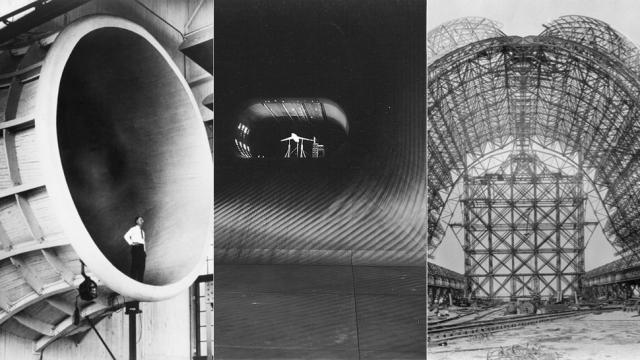“It is easy to invent a flying machine,” said the 19th-century aviation engineer Otto Lilienthalmore, “[and] difficult to build one; to make it fly is everything.” The challenge of air (and later, space) travel began not with building aircraft, but with building a realistic simulation machine in which to test those aircraft.
The same went for NASA, in its earliest incarnations. When I visited a few years ago, the massive warehouses and test sites had mostly been turned into museums. But at one time, those superstructures held the key to putting man into orbit. Massive, yawning wind tunnels, huge scaffolding towers and million-tonne excavation sites were the first concrete (har har) evidence of progress towards space. Sure, the rockets and shuttles stole the show — but there’s a whole bevy of remarkable construction achievements that went along with building them.
Earlier this week, Maria Popova pointed us towards NASA’s public domain archive, where dozens of dramatic images of some of the administration’s first buildings are archived. It’s easy to see how these cinematic spaces must have piqued the eye of filmmakers like Stanley Kubrick; Some of them could be stills from a German Expressionist film, in which huge sculptural walls dwarf the character standing below. They’re historic images, but they’re also incredibly beautiful photographs — check out some of the best below, or head over the archive to see the entire collection.
1950: This photo shows the acoustic housing of the original Supersonic Wind Tunnel. The housing was added because of complaints from neighbours about the noise — so NASA engineers had to build on a noise-dampening section.
1927: At Langley, this Propeller Research Tunnel was the testing site for the first full-scale aeroplane, the Sperry M-1 Messenger. What we’re seeing here is the “exit cone”, where Elton W. Miller, chief of aerodynamics, is standing.
1964: This huge crater-like excavation site was dug to create a foundation for the A-2 test stand, which was built to test and flight-certify the booster system for the Apollo mission.
1960-64: Here’s a test stand under construction — actually, it’s a test stand being completely remodelled, since the early stands weren’t large enough to accomodate the huge stages of Saturn V. It had to hold down the three million kilogram thrust produced by five F-1 engines, so the stand used hundreds of tonnes of steel and five million kilograms of cement — the foundation alone reached 12m below the earth.
1931-34: Hangar One, at the Naval Air Station in Sunnyvale, was one of the largest buildings of its kind. It was built to house the Navy dirigible (!), USS Macon. The hangar could house up to 10 football fields, and has unique doors that “roll back” like an orange peel. After the Macon crashed, it became a training facility.
Another construction shot of the massive Hangar One.
1943: A view of the entrance cone to Ames’ Wind tunnel, with a blimp in the background.
1942: This dramatic view is looking into the cooling tower of the High Speed Wind Tunnel.
1948: After World War II, National Advisory Committee for Aeronautics, or NACA, pushed the wartime engineering boom forward at the Ames Aeronautical Lab, in Moffet Field, California. For example, this High Speed Wind Tunnel, where new ideas about aerospace engineering were hatched in the late 1940s.
1956: A swinging valve at various stages of opening and closing in the Supersonic Wind Tunnel.
1962: A model of the Lockheed C-141 model hangs in the Transonic Dynamics Tunnel, he world’s first aeroelastic testing tunnel — which required a tunnel that could simulate gusts. NASA explains that “by the late 1940s, with the advent of relatively thin, flexible aircraft wings, the need was recognised for testing dynamically and elastically scaled models of aircraft. In 1954, NACA began converting the Langley Pressure Tunnel for dynamic testing of aircraft structures. The old circular test section was reduced to 5m x 5m, and slotted walls were added for transonic operation. A model support system was devised that freed the model to pitch and plunge as the wings started oscillating in response to the fluctuating airstream.”
1947: Here, we’re looking “down the throat” of the world’s largest tunnel, the 40 x 80 foot wind tunnel at Ames. At top speed, six fans would drive air at 65km/h. That model at the top looks small — but actually, it’s almost 15m long. It’s mounted on stilts because it’s undergoing drag tests; NACA readily supplied that data to American aircraft engineers.
1957: Engineers inside of the Supersonic Wind Tunnel check on a model of a supersonic aircraft.
1950: Remember the sharp corners of the wind tunnel above? It was a challenge to get the air to flow smoothly through the corners, so engineers designed these weather-vane-like slats (seen here at the Pressure Wind Tunnel at Langley), which forced the air to turn corners more smoothly. Without the vanes, turbulent eddies would’ve skewed the test data.
